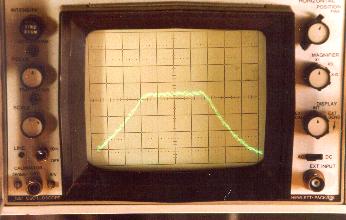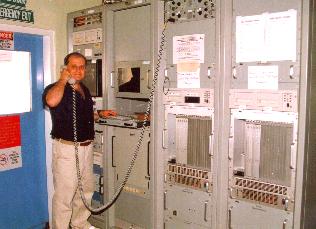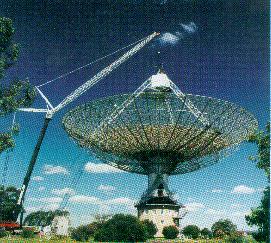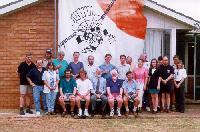Soon after the Galileo spacecraft was launched in October 1989, the
spacecraft's main communications antenna failed to unfurl properly. Unlike
on previous spacecraft, the Galileo high-gain antenna was not a rigid
structure. Instead, it was designed to unfurl, like an umbrella, once the
spacecraft was safely en route to Jupiter. Unfortunately, the straps
holding the folded antenna in place failed to respond to commands, and
despite several ingenious attempts to open the antenna, it remained stuck
in a partly unfurled state. This rendered the antenna, designed to
transmit data at rates of up to 134,000 bits per second (bps), useless.
Fortunately, a second, small antenna on the spacecraft was brought into
operation to transmit the precious scientific data. This is a
small rod-type, low-gain antenna that transmits at very low power in all
directions, so that any signal reaching the Earth is extremely weak - weaker
even than the static in the radio receivers on Earth. The difference between
Galileo's sending its data to Earth using the high-gain compared to the
low-gain antenna is like the difference between the concentrated light from
a spotlight versus the light emitted diffusely from a bare bulb.

The passband from the Parkes Galileo receiver. The weak signal is lost in the static on the plateau region of the band. |
To extract the signal from this background static, several tracking
antennas had to be linked together, or "arrayed", and their signals
combined. This boosted the received signal strength enough to let the weak
signal from the Galileo spacecraft emerge in a useable form above the
background static. Because the signal was weak, the data-flow rate had to
be kept very low. To maximise the amount of data transmitted
to Earth, new and very sophisticated data compression techniques were also
designed and implemented. With these changes, the data rate was increased
from an effective 10 bps to a maximum of 160 bps, a great improvement but still
considerably less than the planned rate of 134,000 bps.
This effort salvaged not only the mission from near disaster, but also
salvaged 70% of the science.
ARRAYING
The secret of the Galileo mission's success is due to the linking, or
arraying, of various tracking antennas around the world. This network
originally cost NASA US$30.5 million to establish, and will be used, in
one way or another, for all future planetary missions.
Essentially, the arraying involved linking the 64-metre antenna at Parkes
with the 70-metre antennas of NASA's Deep Space Tracking Network at
Goldstone in California, Tidbinbilla near Canberra, and Madrid in Spain.

The Full Spectrum Resolvers (FSR) were used to extract the signal from the static, and then pass the data to Tidbinbilla for combining. |
As the rotation of the Earth successively brought each station into view of
Galileo, the tracking antenna locked on to the spacecraft orbiting Jupiter
and track it until it set. The positions of the stations around the globe
meant that the tracking periods at each site overlapped for a short time.
It was during these overlap periods that the data rate was
programmed to increase. In fact, whenever Parkes came on line, the data rate
peaked at the maximum achievable rate of 160 bps. It was then that
the Parkes antenna was linked to the 70-m dishes at Goldstone and Tidbinbilla
and to two of Tidbinbilla's 34-metre antennas. So, during this two-hour overlap,
five antennas were pointing at Galileo at the same time.
With the handing over of one station to another, the data rate had to be
constantly adjusted to accommodate the various antennas tracking the
spacecraft.
At times, the spacecraft was as much as 48 light minutes from the Earth,
that is, it took the radio signal 48 minutes to travel from the vicinity of
Jupiter to the Earth. The spacecraft was pre-programmed to alter the rate
at which it transmitted its data to Earth by the correct amount, and at
just the right moment, for it to be received on Earth when the various
stations of the tracking network came into view.
It was imperative that each of the antennas was locked on and tracking the
spacecraft at its scheduled time. Any loss of tracking time, by any of the
dishes in the array, meant that the data were lost. Since the gathered
data were always first recorded on the spacecraft's onboard video tape, any
lost data that the JPL scientists considered important were re-scheduled
for later playback. You may have seen some Galileo images with black
stripes cutting across them. This indicates that during the transmission,
one or several of the antennas was off source, but the data loss was not
deemed serious enough to warrant re-transmitting the missing frames.
PARKES' INVOLVEMENT
It was soon after the antenna problem was diagnosed that the Australia
Telescope National Facility (ATNF) was contacted by NASA/JPL to ask that
the Parkes observatory be allowed to assist in recovering the data from
Galileo.

The new aerial cabin being installed. The old cabin is in the foreground resembling a lunar module. |
In order to commit itself to tracking the spacecraft over such a long
period, and at the same time continue to do general astronomy, the
observatory first had to modify the telescope to accommodate the new
"Galileo" receiver, and to allow observers to swap quickly between
different receivers. To this end, NASA agreed to finance the construction
of a new aerial cabin: the room at the focus of the telescope where the
receivers sit. This new aerial cabin can hold four receiver packages
instead of, as in the old focus cabin, just one, and any of them can be
swung into action within minutes. This increased "frequency agility" means
that the Parkes telescope is now more efficient and flexible than ever
before.
As well as the new aerial cabin, the ATNF built a new low-noise S-band
receiver specifically for picking up Galileo's weak signals. Radio
astronomers can also use it for many other diverse astronomical observations.
The construction of the new aerial cabin was completed in early 1996, and
the first test track was made in March. The contracted tracking ran from
28 October 1996 to 6 November 1997 for about nine hours each day.
THE TRACKING DUTIES
The daily tracks were done by three principal Galileo operators: Dr Ian
Stewart, Mr Russell Pace and Mr John Sarkissian with occasional help from
other observatory staff.
As the seasons changed, the starting times of the daily nine-hour tracks
slowly migrated through the day. Over the year, the tracks shifted from
being wholly in daylight to wholly at night. The night tracks often saw us
alone at the telescope quietly going about our tasks. During the early
morning drive from the telescope to the town, operators often had to dodge
kangaroos and rabbits along the way, while Jupiter rose, beckoningly.

Some of the Galileo operators, at the end of the last Parkes Galileo track - 6 November 1997. |
During the tracks, operators constantly monitored the status of the
telescope and the receiver, ever ready to take immediate steps if
anything untoward should happen. Track time was seldom lost but, when it
was, it was almost always because of the wind. For structural and safety
reasons, the telescope is designed to stow whenever the wind reaches a
critical speed. This was frustrating but JPL was able to work around it so
that it had little effect on the data reception.
The most serious problem happened in early October 1997, when a critical
component of the observatory's hydrogen maser clock failed. This clock is
extremely accurate and was used to time the arrival of the Galileo signals
so they could be correctly combined with the signals from the other
antennas. Fortunately for us, the Mars Pathfinder probe was experiencing
communications problems at the time so that all Galileo tracking duties
were suspended briefly, not just ours. (In fact, proper contact was never
re-established with the Mars Pathfinder probe.) This break in tracking
gave us enough time to repair the clock, and no Galileo tracking time was
lost as a result.
Another problem came from an unexpected source. The telescope tracking control
system uses a directed laser beam to lock the telescope on to the desired
position in the sky. On balmy summer evenings, moths from the surrounding
fields often infiltrated the room housing the laser, and fly across the
beam, causing the telescope to temporarily lose lock on the tracked position.
This was only a minor irritant and many solutions were proposed; the most
effective weapon turned out to be a rolled-up newspaper. It's odd how such
a little thing as a moth can disrupt very sophisticated technology, and on
a global scale.
On all previous planetary missions, the data rate from the spacecraft had
been high enough to have the data processed in real time and displayed
within minutes of reception. With Galileo, however, the low bit-rate meant
that it often took weeks for the information to be fully received and
processed. And so we saw the magnificent images of the Jovian system when
everyone else did - when they were put on the Internet; there was no
privileged position for us in that respect.
Contrary to the experience on other missions, the encounter periods, when
the spacecraft made close passes of the Jovian moons, were never occasions
of frantic and critical activity at the telescope. Because of the low
bit-rate, the information gathered during these fly-bys was recorded on the
onboard video tapes and played back at leisure in the weeks following the
encounter. The unique and important bits of information were downlinked
first, followed by the less critical information. Sometimes, if not all
the data were downlinked before the next encounter, they were written over.
Such was the way of Galileo.
The Parkes Galileo team developed an excellent working relationship with
the various tracking teams at Tidbinbilla and JPL. We were often able to
solve problems before they arose and posed a threat to the data acquisition.
CONCLUSION

Celebrating the end of the Galileo tracks. Parkes Observatory staff - 14 November 1997. |
On 6 November 1997, the Galileo spacecraft passed the smallest of Jupiter's
big moons, Europa. With this encounter, its initial eleven- orbit tour of
the Jovian system came to an end and so did the Parkes telescope's Galileo
tracking duties. We at the observatory are very proud that no tracking
time was lost due to equipment failure or operator error. We tracked the
spacecraft for more than 97% of the assigned tracking time, greatly
exceeding all expectations.
The spacecraft will perform for a further two years in the extended
"Galileo Europa Mission" (GEM). It will gather new and vital information
about the Jovian system, in particular the moon Europa. Eight close
fly-bys of the moon are scheduled, followed by four fly-bys of the
second-largest Jovian moon, Callisto. In a grand final, Galileo will pass
through the Jovian radiation belts and encounter Io once or twice more.
Though Parkes will not be involved in this extended mission, we all wish
the NASA/JPL Galileo team continued success and good fortune. We look
forward to seeing the sweeping images of the awesome Jovian vistas.
It has been a privilege for the observatory to share in the acquisition of
so much new knowledge of the Jovian system. With its participation in this
mission, the observatory has continued its proud record of contributing to
the success of some of the most significant and historic space missions.
John M. Sarkissian.
Co-ordinator of Galileo Tracking Operations
Parkes Radio Observatory,
Australia Telescope National Facility.
November, 1997.




